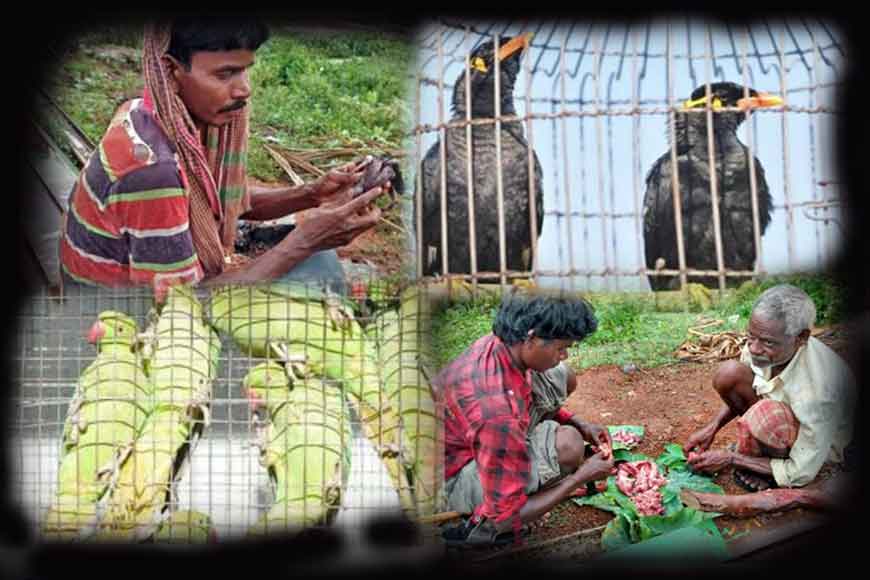Bird hunting tribe of Bengal – The Pakhmaras

Globalization has had a significant impact on rural India over decades. Through urbanization, the light of modernity has been able to reach the remote villages. Efforts have been made to educate the underprivileged residing far away from the world of ‘enlightenment.’However, at times such modern world have impacted tribes and their lifestyles drastically.
On the banks of river Ajay, and on the outskirts of Aushgram, Durgapur and Asansol, still survive the Hunting Tribe of Bengal --- The 'Pakamaras.' Unfortunately, they are almost on the verge of extinction. Many of them are giving up their nomadic lifestyle and settling down. One can trace their settlements near Gushkara station, Murshidabad, Dombhani, Ukhra, Loudoha, Faridpur or Haripur. And it is next to impossible to realise that this tribe once upon a time earned their livelihood by hunting birds in the forest.
In 1891, Herbert Hope Rizzle wrote in his book Tribes and Castes of Bengal, that just like Chirimar, Bede, Minashikaris, ‘Pakhmara’ belong to a group of hunting community who live around Jamtara, Dumka, Godda and Hazaribagh. To escape from the hands of the English during Santhal and Chuar uprising, the community had spread out in and around the mining areas of Asansol. Later, some came to eastern Burdwan in search of birds. But at least until the end of the nineteenth century, they used to live the life of itinerants. During the nineteenth and twentieth century, they used to sell birds in the market near various mines. But that was not enough for their living. They used to make bears and monkeys dance, which is popularly known as ‘bhaluknach’ or ‘badornach’ in Bengal in exchange of rice, pulses, flour from the villagers. From the Medieval Age, many of them hunted vultures, owl, monkeys and sold their body parts to the physicians.
‘Pakhmaras’ used to hunt birds with a weapon named Satnoli and hunting traps made of bamboos. Seven bamboos were placed beside each other and a heavy metal used to be installed to make Satnoli. Even if a bird was sitting on the high branches of the tree, they could kill the bird with the weapon effortlessly even from a distance. They used to burn these birds and eat. Apart from this, they also sold various parts of these birds like feather and bones. In terms of language, culture and hunting methods, ‘Pakhmara’ have similarities with South Indian Malpahari people. Like Malpahari, they have a code language to communicate with each other. Anthropologists believe that ‘Pakhmara’ had four sub-groups-Jarasand, Kalketu, Phullara, Jangipuri and Daihati. Among them, 'Kalketu-Phullara' belong to a high position of the society. The subgroup depends on the species of the birds that were hunted.
Once upon a time, this community drove away foxes from and make settlements by clearing forests. In the 19th century, any Bijoya Dashami was not complete without the Pakhmaras unchaining the Neelkantha bird. In the Bardhaman Rajbari, King Kirtichand used to conduct an event and made hundreds of Nilkantha birds fly on the day of Bijoya Dashami. These birds used to be collected by the ‘Pakhmaras’. Apart from hunting birds and selling their body parts, many of them collected honey from the various jungles of Rarh Bangla.
The religious beliefs of Pakhmaras are also highly dynamic. They worship trees like Banayan, Asathwa in various parts of Murshidabad. Pakhmars of Birbhum worshipped Dharmathakur and sacrificed goats.Turtle meat is also forbidden to them. Shiva is one of the most worshiped gods of Pakhmaras. Pakhmaras apply their own blood on Belpata and offer them to Lord Shiva while the same community of Haripur offer the blood of birds to the lord. But with hunting of birds restricted in most areas and also made illegal, the tribe had to settle down gradually. Some of them became rickshaw pullers while others turned Bahurupees. Pakhmaras have come a long way from their nomadic gypsy life and embraced modernity to an extent but the community has not swayed away from some of their anachronistic ideologies.









